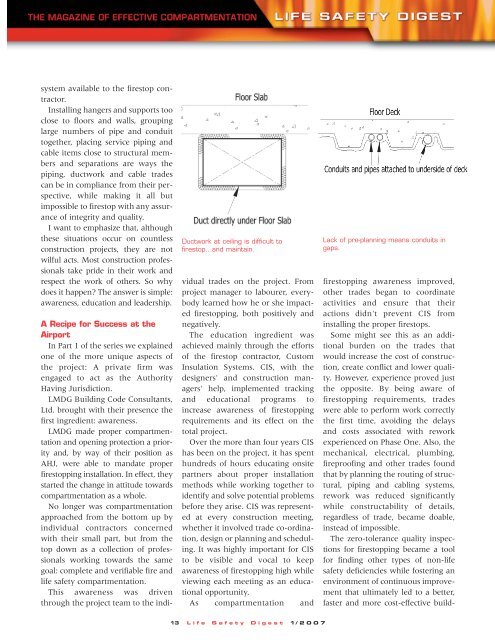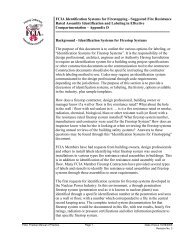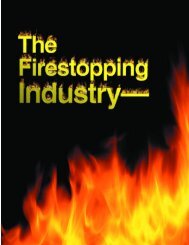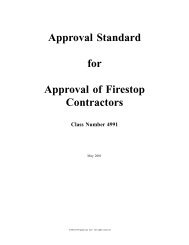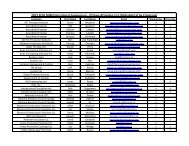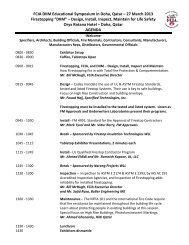Winter 2007 - FCIA - Firestop Contractors International Association
Winter 2007 - FCIA - Firestop Contractors International Association
Winter 2007 - FCIA - Firestop Contractors International Association
Create successful ePaper yourself
Turn your PDF publications into a flip-book with our unique Google optimized e-Paper software.
system available to the firestop contractor.<br />
Installing hangers and supports too<br />
close to floors and walls, grouping<br />
large numbers of pipe and conduit<br />
together, placing service piping and<br />
cable items close to structural members<br />
and separations are ways the<br />
piping, ductwork and cable trades<br />
can be in compliance from their perspective,<br />
while making it all but<br />
impossible to firestop with any assurance<br />
of integrity and quality.<br />
I want to emphasize that, although<br />
these situations occur on countless<br />
construction projects, they are not<br />
wilful acts. Most construction professionals<br />
take pride in their work and<br />
respect the work of others. So why<br />
does it happen The answer is simple:<br />
awareness, education and leadership.<br />
Ductwork at ceiling is difficult to<br />
firestop…and maintain.<br />
A Recipe for Success at the<br />
Airport<br />
In Part 1 of the series we explained<br />
one of the more unique aspects of<br />
the project: A private firm was<br />
engaged to act as the Authority<br />
Having Jurisdiction.<br />
LMDG Building Code Consultants,<br />
Ltd. brought with their presence the<br />
first ingredient: awareness.<br />
LMDG made proper compartmentation<br />
and opening protection a priority<br />
and, by way of their position as<br />
AHJ, were able to mandate proper<br />
firestopping installation. In effect, they<br />
started the change in attitude towards<br />
compartmentation as a whole.<br />
No longer was compartmentation<br />
approached from the bottom up by<br />
individual contractors concerned<br />
with their small part, but from the<br />
top down as a collection of professionals<br />
working towards the same<br />
goal: complete and verifiable fire and<br />
life safety compartmentation.<br />
This awareness was driven<br />
through the project team to the individual<br />
trades on the project. From<br />
project manager to labourer, everybody<br />
learned how he or she impacted<br />
firestopping, both positively and<br />
negatively.<br />
The education ingredient was<br />
achieved mainly through the efforts<br />
of the firestop contractor, Custom<br />
Insulation Systems. CIS, with the<br />
designers' and construction managers'<br />
help, implemented tracking<br />
and educational programs to<br />
increase awareness of firestopping<br />
requirements and its effect on the<br />
total project.<br />
Over the more than four years CIS<br />
has been on the project, it has spent<br />
hundreds of hours educating onsite<br />
partners about proper installation<br />
methods while working together to<br />
identify and solve potential problems<br />
before they arise. CIS was represented<br />
at every construction meeting,<br />
whether it involved trade co-ordination,<br />
design or planning and scheduling.<br />
It was highly important for CIS<br />
to be visible and vocal to keep<br />
awareness of firestopping high while<br />
viewing each meeting as an educational<br />
opportunity.<br />
As compartmentation and<br />
Lack of pre-planning means conduits in<br />
gaps.<br />
firestopping awareness improved,<br />
other trades began to coordinate<br />
activities and ensure that their<br />
actions didn't prevent CIS from<br />
installing the proper firestops.<br />
Some might see this as an additional<br />
burden on the trades that<br />
would increase the cost of construction,<br />
create conflict and lower quality.<br />
However, experience proved just<br />
the opposite. By being aware of<br />
firestopping requirements, trades<br />
were able to perform work correctly<br />
the first time, avoiding the delays<br />
and costs associated with rework<br />
experienced on Phase One. Also, the<br />
mechanical, electrical, plumbing,<br />
fireproofing and other trades found<br />
that by planning the routing of structural,<br />
piping and cabling systems,<br />
rework was reduced significantly<br />
while constructability of details,<br />
regardless of trade, became doable,<br />
instead of impossible.<br />
The zero-tolerance quality inspections<br />
for firestopping became a tool<br />
for finding other types of non-life<br />
safety deficiencies while fostering an<br />
environment of continuous improvement<br />
that ultimately led to a better,<br />
faster and more cost-effective build-<br />
13 Life Safety Digest 1/<strong>2007</strong>


